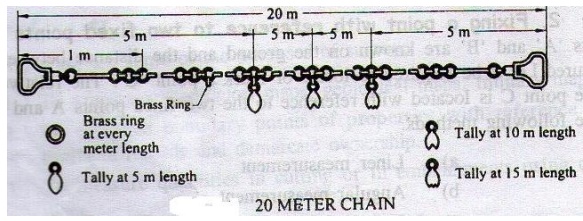Chapter: Civil Engineering : Surveying and Civil Engineering Materials
Instruments used for chain surveying

Classification of surveying:
According to the instruments used, the surveying is
classifieds follows:
ü chain
surveying
ü compass
surveying
ü theodolite
surveying
ü plane
table surveying
ü tachometric
surveying etc.
Instruments used for chain surveying:
The various instruments used in chain surveying are as
follows.
ü chain
ü arrows
ü pegs
ü ranging
rods
ü offset
rods
ü plumb bob
1. Chain:
Chains are used to measure horizontal distances.
Chains are formed of straight links of galvanized mild steel wire called links.
The ends of each link are bent into a loop hand connected together by means of
three oval rings which afford flexibility to the chain.

The chain s made of mind steel.
The ends of the chin are provided with brass handles for dragging the chain on
the ground. the outside of the handle is the zero point or the end point of the
chain and the length of the chain measured from the outside of one handle to
the outside of the other. The length of a link is the distance between the
centers of the two consecutive middle rings.
The end links include the
handles. Metallic tags are indicators of the chain to facilitate quick reading of
fraction of a chain in surveying measurements. Metric survey chains are
available in lengths of 20m and 30m. The 20m chain contains 100 links whereas
30m. Chain contains 150 links. One link of both the type of chain measure 20cm.
2. Arrows:
Arrows or making pins are made of
tempered steel wire 4mm in diameter and generally 10 arrows are supplied with a
chain. An arrow is inserted into the ground after the chain length is measured
on the ground. Usually the length of an arrow is 40cm and one end of it is made
sharp and the other end is bent into a circle for facility of carrying.
3. Pegs:
Wooden pegs are used to mark the
positions of the stations terminal points of a survey line. They are made of
hard timber, generally 2.5cm or 3 cm square and 15cm long, tapered at the end.
4. Ranging Rods
The ranging rods are used for
making the positions of stations and for ranging the lines. They are made of
ell seasoned straight grained timber teak. They circular in cross section of
3cm diameter and have a length of either 2 or 3cm, lengh being more common.
They are shod at the bottom with a heavy iron points. In order to make them
visible at a distance, they are pained alternatively black and white or red and
white.
5. Offset
Offset rod is similar to that of
ranging rod. They are should with pointed iron shoe at one end, ad provided
with a notch or a hook at the other for pulling or pushing the chain through a
hedges or other obstructions.
6. Plumb Bob
While chaining along sloping
ground, a plump is required to transfer the points to the ground. It is also
used for accurate centering of the theodolite compass, plane table etc over a
station mark and for testing the vertically of ranging poles
7. Cross staff
This is the instrument used for
setting out right angles to a chain line. It consists of either a frame or box
with two pairs of vertical slits and is mounted on a pole shod for fixing in
the ground
ü Open
cross staff
ü French
cross staff
ü Adjustable
cross staff
Principle of Chain Surveying
The rectangle is the simplest fig that can be
plotted from the lengths of its sided. Based on this, the principle of chain
surveying is to divide the area to be surveyed into a network of connected
triangles. Hence chain surveying is some times called chain triangulation. The
exact arrangement of triangles to be adopted depends upon the shape and
configuration of the ground and obstacles met with. When it contains no angle
smaller than 30degree greater than 120 degree.
Advantages and Disadvantages of
chain surveying Advantages:
ü Chain
surveying is suitable for fairly level ground
ü It does
not require costly equipments
ü It is
used for preparing plans of smaller area
ü It is
simple
Disadvantages
ü It is
cannot used for large areas
ü It is not
always accurate
Related Topics